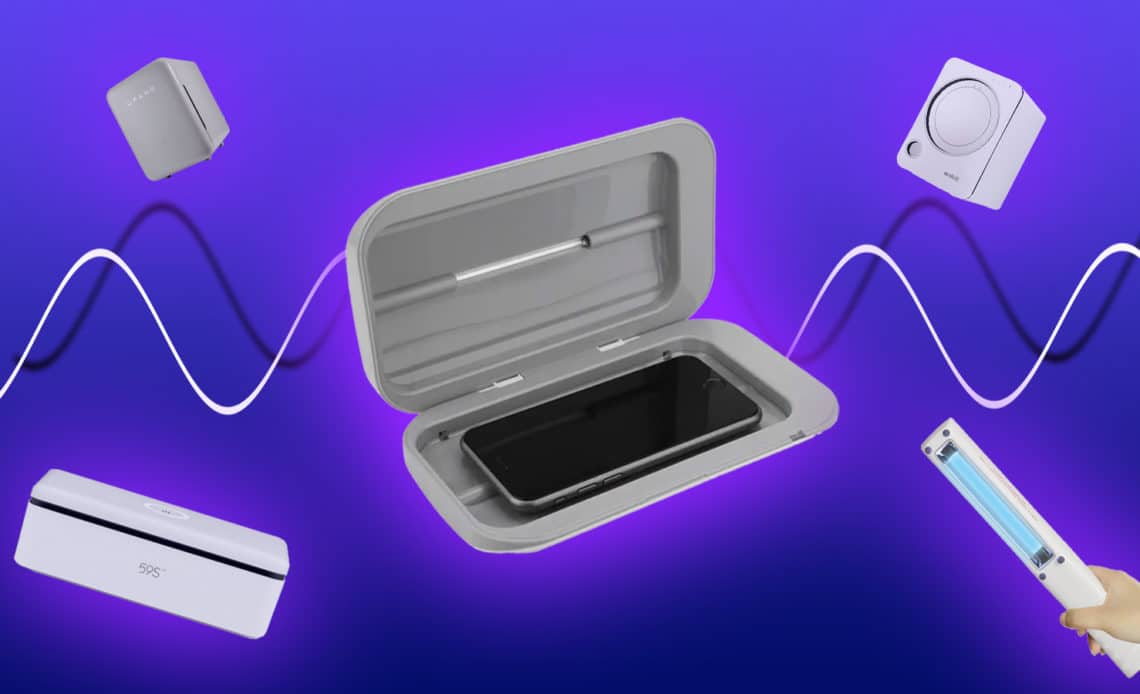
Longread alert! This is the best and most thorough review of UV light sanitizers online. There are lots of fake and low-quality portable UV sanitizers out there, and understanding how UV light sanitation works is crucial to properly using even a high-quality device. When used correctly, a high-quality ultraviolet light sanitizer is a great protector against Covid-19 and everyday germs. To use this review, start with the most recent news and our in-depth explainer on the question “Do UV sanitizers work?” Or, if you want to skip to the effectiveness of different UV products, click here.
Table of Contents
Best UV Sanitizer, Best UV Sanitizing Wand, Best UV Phone Sanitizer, And Other Portable UV Light Devices At A Glance
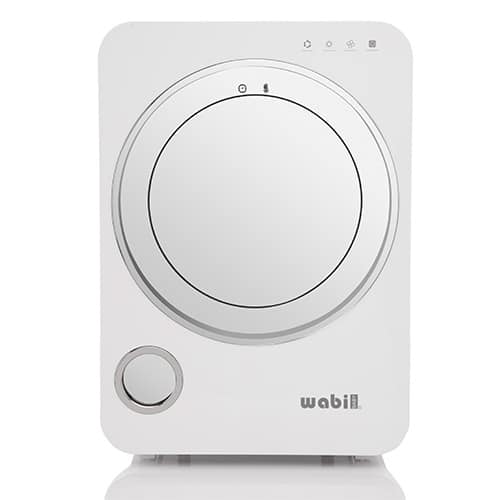
Best UV Sanitizer
Wabi Baby UV Sanitizer
For those looking for quality, Wabi is the one. Since this product is intended for sanitizing baby bottles, pacifiers, and other baby products, it is highly regulated and trustworthy. In fact, the Wabi device has been tested for a strain of human coronavirus and found to create a 99.9% reduction.
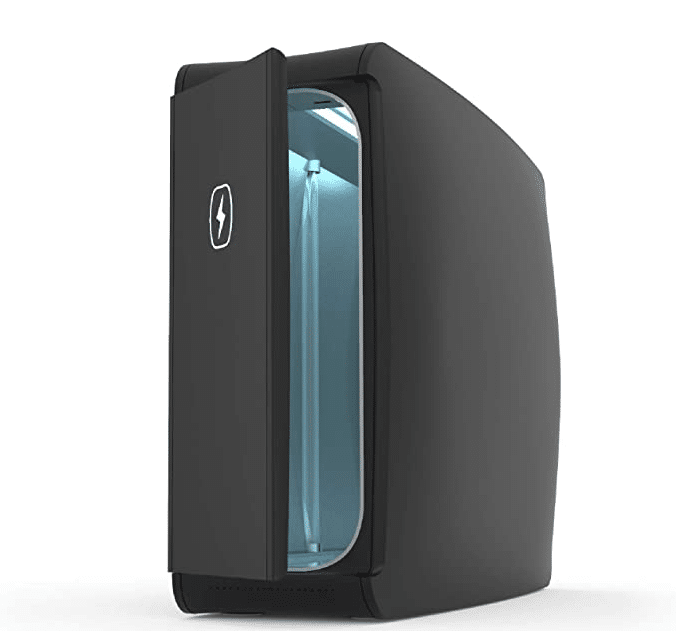
Runner Up For Best UV Sanitizer
HomeSoap UV Sanitizer
The HomeSoap will disinfect your devices in about 10 minutes and can fit a fair amount of stuff inside it, from phones and tablets to headphones and TV remote controls.
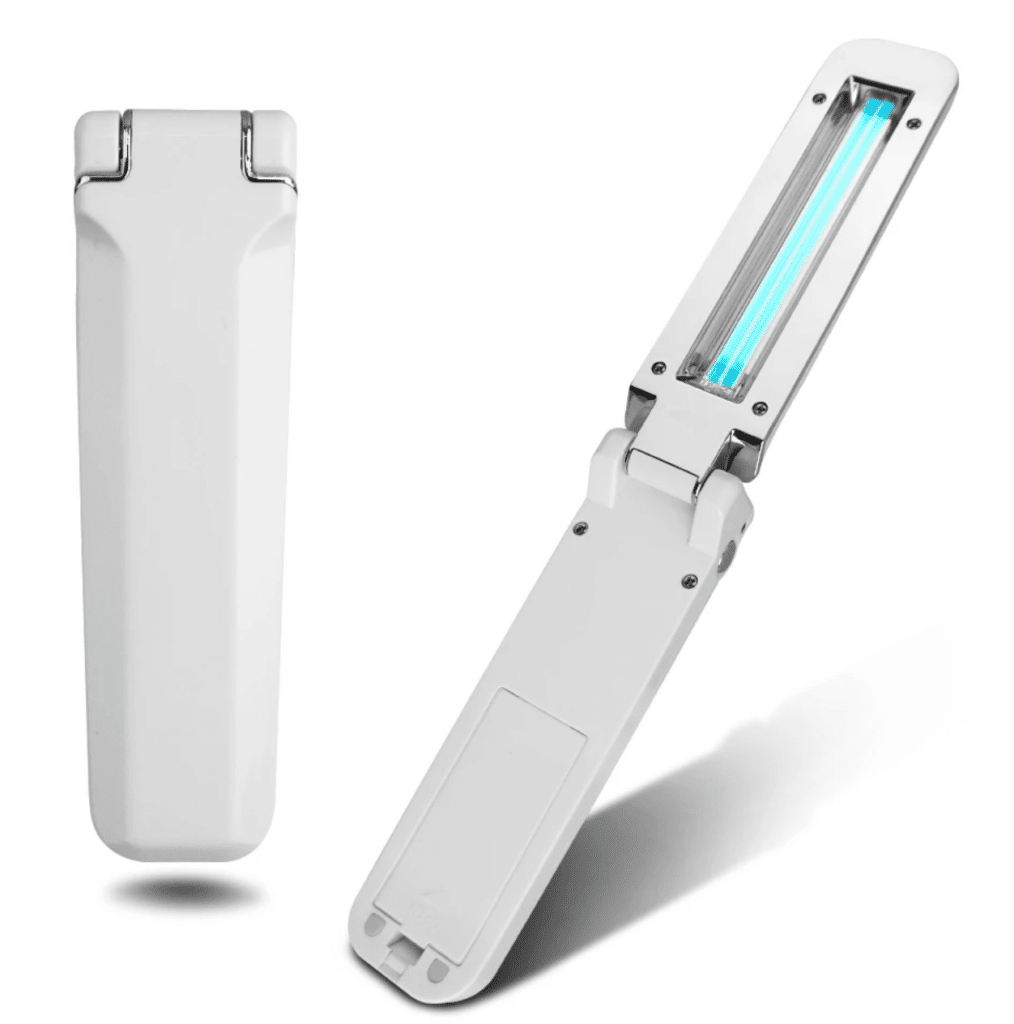
Best Portable UV Sanitizer
UVLIZER Extra Powerful UV Light Sanitizer
UVLIZER’s UV light sanitizer uses 2 watts to disinfect surfaces, meaning that you should be able to disinfect surfaces with the UVLIZER at a distance of an inch for just under 30 seconds. It’s LED powered.
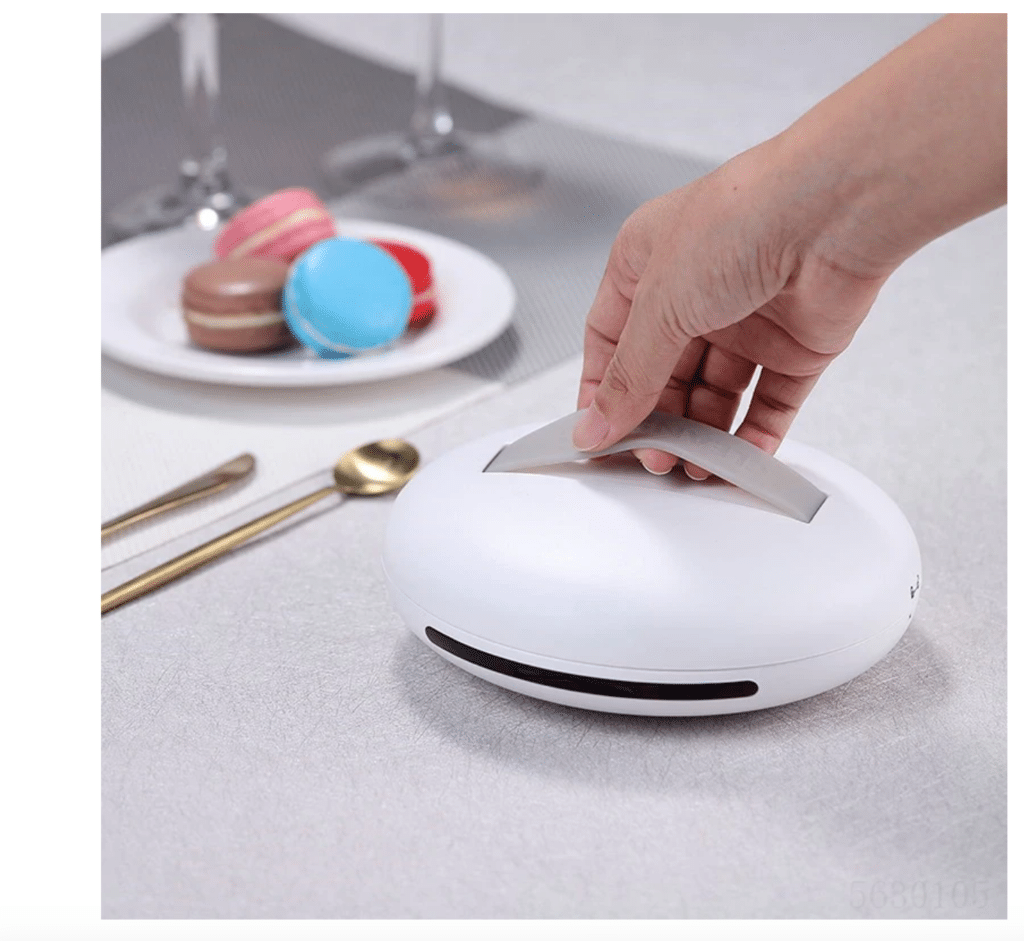
Best UV Sanitizing Bot
UVLizer UV Sanitizing Bot
This portable Roomba-like device uses 3.4 W—which you can assume emits around a watt of UV-C light—to automatically sanitize surfaces when you’re on the go.
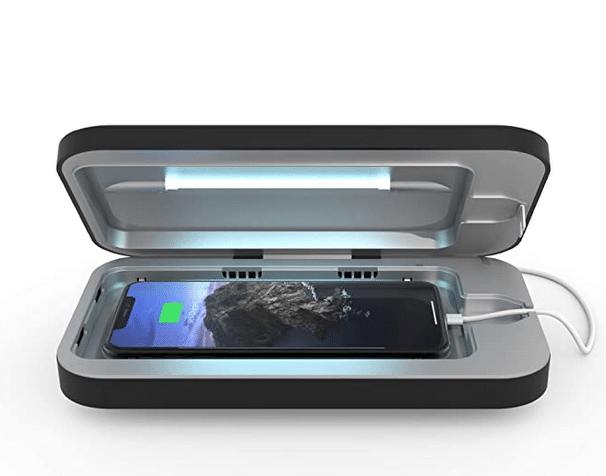
Best UV Phone Sanitizer
PhoneSoap 3 UV Phone Sanitizer
PhoneSoap is built for all smartphones and charges your device while it’s sanitized. It only takes 10 minutes to sanitize and is available in a variety of colors.
2021 Update: Scientific And Medical Studies Continue To Provide Evidence That Using A Portable UV Light, UV Light Sanitizer Box, Or Other Ultraviolet Light Sanitizer Is An Effective Way To Destroy Germs And Covid-19
When we published this review in April 2020, COVID-19 was headed toward its first peak in the United States, which eventually occurred around August. Experts, of course, warned of an Autumn/Fall second wave of coronavirus, which the US ended up experiencing as well.
We published our UV light sanitizer review because we guessed that, as people became more aware of the dangers of COVID-19, they would be looking for safe and effective solutions for sanitizing their devices, homes, cars, etc. We spent a lot of time researching the subject—even going as far as to consult a theoretical physicist about the science of how UV radiation destroys the DNA and RNA of germs, rendering them inert—because we saw that there were tons of handheld UV light products for sale that were, to our eyes, of dubious quality.
Since April, UV light sanitizers have become much more popular, for consumers, corporations, and especially at hospitals. New medical and scientific literature confirming the effectiveness of UV light sanitizers has also been published in reputable journals. For example:
- A September 2020 article in Global Health: Science and Practice, authored by nine doctors out of the University of Delaware, documents their process of creating a scalable, low-cost PPE sanitizing system using off-the-shelf UV sanitizer products
- A September 2020 study published in Frontiers in Microbiology by researchers at the University of Tennessee found evidence suggesting that coronaviruses are “highly sensitive to UV-C light compared to other…viruses”
- A September 2020 literature review published in the international peer-reviewed open access journal Pathogens concluded that UV sanitizers can inactivate SARS-Cov-2 using mercury lamps, eximer lamps, pulsed light, and LED; effectiveness varies by surface
As the literature has provided more and more evidence for the effectiveness of using a UV light sterilizer box—or any other ultraviolet light sanitizer—we’ve also seen a number of high-profile websites publish UV want reviews of their own. To our dismay, they include recommendations for products that are potentially ineffective, as well as broken links. For example, Forbes recommends shoppers buy UV light sanitizers whose companies do not disclose wattage or lumens, making it impossible to know if the products are effective. This is also true of New York Magazine’s review.
Our UV light sanitizer review recommends the best UV sanitizers on the basis of wattage and lumens, which we believe is the most trustworthy signal that tells us the product is effective. If we recommend UV light sanitizers that don’t disclose wattage or lumens, it’s because there are other reasons to believe in the trustworthiness of the products, such as company reputation or published lab results. We will continue to add new, trustworthy UV light sanitizers to this review as we continue our research, and are committed to earning and keeping your trust as a high-quality source of information about UV light.
What is Ultraviolet Radiation?: The Visible Light Spectrum And UV Light
The “electromagnetic spectrum” is the name given by scientists to all the light in the universe—visible and invisible. As the name describes, it’s a range of electro-magnetic radiation. Light travels as a wave, and the spectrum is arranged by size of wavelength. Radio waves are huge—the length of a building. They sit off on the left-hand side of the spectrum. By contrast, x-rays are atomic-level tiny, and sit off to the right. The light that we see, also known as “white light” and which we recognize in the colors of the rainbow, sits in the middle.
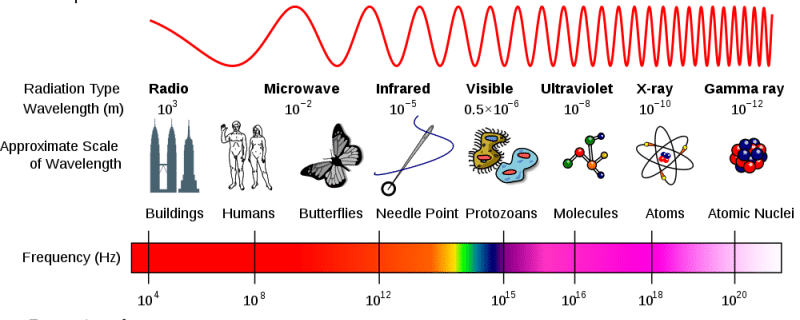
Across the visible part of the spectrum (aka the rainbow), red light is a little bigger, blue and violet light is smaller. Just outside of the visible range, we find ultraviolet light. (For clarity, in science, “light” is just another type of radiation. So “ultraviolet light” and “ultraviolet radiation” can be used interchangeably).
UV light itself is then broken into three groups—UV-A, UV-B, and UV-C. UV-A is the longest wavelength, and UV-C is the shortest. Of that which reaches the earth from the sun, UV-A reaches us the most. UV-A is responsible for wrinkling and skin aging. UV-B has shorter wavelengths than UV-A, meaning it is closer on the spectrum to an x-ray, where UV-A is closer blue/violet visible light. And just like x-rays, these shorter, more energetic waves have a higher likelihood of disrupting cellular function and causing cancer in humans. This is why a good sunscreen will tout “full spectrum UV-A and UV-B protection.”
UV-C is even shorter and more potentially harmful than UV-B, but fortunately, the waves are too short to make it through the earth’s atmosphere. Exposure could give a human being a severe sunburn in a matter of seconds. To bacteria and viruses, UV-C is downright deadly.
Do UV Sanitizers Work? How Does UV Light Kill Germs?
Scientists and medical professionals have used UV light to kill germs and sanitize equipment for over 100 years. The process is called ultraviolet germicidal irradiation (UVGI).
As part of the 2020 COVID-19 crisis, ultraviolet sterilization became a front line technique for avoiding viral spread. UV-C robots clean hospitals, and banks use UV light to clean bills. Boeing is even developing a UV-based self-cleaning bathroom for its planes.
Ultraviolet germicidal irradiation works for essentially the same reason UV light exposure can give you cancer. The wavelength of UV-C light in particular is the right size to be absorbed by the RNA or DNA of a virus or cell. Absorbing light means absorbing energy—it’s why things get warm when they sit in the sun. When the DNA or RNA absorbs this energy from the UV radiation, it comes apart. This is known as a photolytic process. With the DNA or RNA destroyed, the virus or bacteria is rendered inert and is no longer harmful.
Types of UV Disinfection Lamps: Low-Pressure Mercury vs. LED
High-end and industrial UV-C disinfection lamps are most typically low-pressure mercury vapor lamps. If you are looking for extremely high quality, this is your best choice, though it will be a more expensive purchase. Mercury-vapor lamps emit a high amount of UV-C at 254 nm wavelength, which is the ideal wavelength for bacterial and viral DNA/RNA destruction.
Low-pressure lamps have less power than higher pressure versions, meaning they require a longer exposure time (and/or need to be held closer to the object they’re disinfecting), but they do not get as hot and they use power more efficiently. Most consumer versions of mercury-vapor lamps will be low-pressure.
Light-emitting diode (LED) versions have recently become available, and they are typical in smaller, lower-powered, consumer-focused devices. LEDs are durable and extremely efficient, meaning they can be used in small, portable, and battery-powered devices. LED-based UV sanitizer devices also tend to be less expensive than their mercury counterparts.
However, LED-based devices are going to have a much wider range of quality. Because they are lower-powered, most LED UV Sanitizers will need to be held much closer to the object for a longer period of time. Some LED-based devices are cheap knockoffs, too underpowered to have a meaningful disinfecting effect. As such, we recommend you consult our table below, and that you do not buy any LED-based sanitizing device that does not disclose either its wattage or lumens.
Some LED-based devices are cheap knockoffs, too underpowered to have a meaningful disinfecting effect.
UV Sanitizer Effectiveness: Power And Dosage Are Crucial Buying Criteria
The disinfection power of a UV light is a function of the strength of the light (the technical term for this is irradiance), the distance from the object being disinfected, and the time of UV exposure.
Scientists measure the strength of the UV light on a surface in terms of milliwatts per square centimeter (mW/cm2). A watt is a unit of power, or energy per time. (You will often see “microwatts” referred to as well. The “milli” prefix means one one-thousandth of a watt; “micro” means one one-millionth.)
Guidance on the dosage of UV radiation required to kill pathogens varies. Disinfecting drinking water at 90% effectiveness requires between 2,000 and 8,000 microwatts per square cm, and the U.S. EPA requires at least 2,500. However, disinfecting drinking water is different from disinfecting a surface.
A key study shows 99.9% kill rates for bacteria at a strength of 15.54 mW/cm2 (15,540 microwatts) at a distance of about 1 inch for 5 seconds. Another compares low- and medium-pressure lamps effectiveness at 5, 15, and 40 mW/cm2. A third recommendation set from a UV system manufacturer sits in the same range for 99% disinfection. A fourth vendor calculator claims their 55W bulb irradiates 99.9% of common viruses at a distance of 16 inches in 24 seconds, and at a distance of 12 inches in 8.5 seconds. In studies of a keyboard disinfection device, a UV light with a power of 40-45W killed 99.9995% of E. Coli bacteria in 90 seconds at a distance of approximately 1 inch.
The UV output of a lamp for disinfection purposes depends on a lot of conditions, including the shape of the lamp (a circular bulb broadcasts its energy in all directions, only some of which is pointed at the target), the temperature of operation (which changes the pressure inside the lamp), and the age of the bulb. The distance from which you disinfect matters a lot. The UV energy applied to a surface decreases as the inverse square of the distance from the bulb. This means moving the bulb from 12 inches to 24 inches away from the surface does not reduce the power by half, it reduces the power by 4x.
Also of note is the fact that the watts advertised by the lamp refers to the total energy output. While these lamps focus on the production of UV-C light (of approximately 254 nm wavelength), they don’t exclusively produce UV-C. As a rule of thumb, assume about 33% of the advertised wattage is germ-killing UV-C wattage.
The Unwinder’s UV-C Dosage Recommendation Table
Given the uncertainty around UV-C effectiveness, The Unwinder worked with a PhD theoretical physicist to create a conservative model to help you make educated choices about the power, distance, and time at which you should use different UV disinfection products.
As a rule of thumb, assume about 33% of the advertised wattage is germ-killing UV-C wattage.
The available data outlined above suggests an application of at least 100,000 microwatt-seconds/cm2 to ensure 99%+ disinfection rates. Confirming the studies is this manufacturer’s chart showing all viruses destroyed to 99% at or below the 100K intensity threshold. The table below calculates to this threshold.
Some of the assumptions, for example the assumption of a round bulb emitting energy equally in all directions, are purposefully conservative, as is the 100,000 microwatt-seconds/cm2 threshold. Many products in this space include some type of reflective component in order to increase the irradiance onto the desired surface. Some manufacturers may dispute our recommendations. However, because this is a matter of household safety, we feel strongly that it is better to be conservative than loose.
| UV Bulb Advertised Watts | Assumed Actual UV-C Watt Output | Distance From Surface | Min. Time to 99% Disinfection |
| 25W | 8W | 4″ | 16 Seconds |
| 40W | 8W | 8″ | 63 Seconds |
| 60W | 8W | 12″ | 142 Seconds |
| 40W | 13W | 4″ | 10 Seconds |
| 40W | 13W | 8″ | 39 Seconds |
| 40W | 13W | 12″ | 89 Seconds |
| 60W | 20W | 4″ | 7 Seconds |
| 60W | 20W | 8″ | 26 Seconds |
| 60W | 20W | 12″ | 59 Seconds |
LED-Specific UV Dosage: Lumens For Disinfection
LEDs present a slightly different conversion problem. First, most LED manufacturers measure their output in lumens, not watts. Second, LEDs generally have a lower ratio of watts to UV-C watts than mercury-vapor lamps. As such, we’ve reduced that figure in our calculations from 33% to 16%. Third, even when a manufacturer discloses lumens, a second variable, called “luminous efficacy” is required to convert lumens to wattage. As few UV-C LED makers disclose luminous efficacy, we assume a conservative figure of 80 lumens/watt. Finally, we only recommend UV sanitizers that specify that their emissions are indeed in the UV-C spectrum (200 – 280nm). Higher frequency UV light (300nm or greater) may be used for novelty blacklights but does not have significant disinfection power.
We caution you against products that do not disclose data. However, in an emergency, you may have no choice. In this case, try to guess if the product uses a high-quality UV-C LED like this one, which can disinfect to 99% in just under 5 minutes at 1″ distance. This is just fine for something like sanitizing your phone or baby products. A product that looks like it uses a low-quality LED strip, like this one, is best avoided.
| Lumens | Watts | Assumed Actual UV-C Watt Output | Distance From Surface | Min. Time to 99% Disinfection |
| 300 | 3.75 | 0.6 | 1″ | 14 Seconds |
| 700 | 8.75 | 1.4 | 1″ | 6 Seconds |
| 700 | 8.75 | 1.4 | 3″ | 52 Seconds |
| 1500 | 18.75 | 3.0 | 1″ | 3 Seconds |
| 1500 | 18.75 | 3.0 | 3″ | 24 Seconds |
| 1500 | 18.75 | 3.0 | 6″ | 97 Seconds |
| Generic LED Strip | 0.18 | 0.029 | 1″ | 282 Seconds |
You can see from both tables that closer is better. When using these products, shine the light onto the surface from the shortest distance possible (without actually touching the surface). Also remember that UV light is only effective where it can shine. If the light cannot shine directly in a crack or crevice, it cannot disinfect bacteria or viruses that might be in the crack.
Cautions When Using UVGI
Exposure to most forms of UV-C can damage your skin, causing very quick and severe sunburns, and raises your cancer potential. Particular caution should be taken to avoid direct exposure of UV radiation to the eyes, as this can cause significant damage and eventually blindness. A good rule of thumb is to simply avoid shining the lights directly on your skin, and taking extra caution that children do not play with the lights.
UV radiation will also, over time, damage materials like plastic and rubber, and the paint or coatings on things like furniture, countertops, and consumer electronics. This should be no surprise—we’ve all seen the hot summer sun damage the paint on a house or the rubber in our cars. Fortunately, the amount of UV-C needed for disinfecting household objects at a normal frequency should not cause significant damage.
Finally, there is a possibility that cheaply-made or knock-off UV-C sanitation lights will emit ozone. Ozone is a primary component of smog, an environmental pollutant that is irritating and dangerous to the respiratory tract, and can cause itchy eyes and sniffles. High-quality UV-C lamps, however, are coated to minimize ozone output.
Coming innovations in “far UV-C” technology hold promise for UV-C disinfection products that do not pose risks to people.
Overall: Best UV Light Sanitizer

Our Top Overall Choice
Wabi Baby UV Sanitizer
Yes, we’re recommending a baby product as our top choice. The fact is, it doesn’t matter if this is marketed for baby gear—this thing is the real deal. Because this product is for sanitizing baby products, it’s highly regulated and trustworthy. Wabi also discloses that their UV lamps are manufactured by Osram/Puritec—most other devices are not this transparent about their parts. It also features a 2-year warranty and several other useful features not seen in other UV products. If safety is top of mind for you, go with this Wabi device.
Editor’s Update, August 2020: the Wabi device has been tested for a strain of human coronavirus and found to create a 99.9% reduction. The Wabi is an FDA-registered medical device.
Runner Up: Best UV Light Sanitizer

Our runner up UV sanitizer recommendation
HomeSoap UV Sanitizer
The HomeSoap will disinfect your devices in about 10 minutes, and can fit a fair amount of stuff inside it, from phones and tablets to headphones and TV remote controls. It charges via USB, and it’s one of the most aestetically pleasing, well-designed devices we’ve seen in the space.
While we can’t find wattage or lumens output for HomeSoap’s UV sterilizer device, we’re confident they’re a trusworthy brand. Multiple HomeSoap users have used laboratories to test the effectiveness of their devices, and the results are impressive. HomeSoap has also been featured on Good Morning America, the Discovery Channel, and QVC. We have reached out to HomeSoap to request wattage output of their bulbs, and will update this review if we hear back from them.
Best UV Sterilizer (Light Box)
Children’s products are well-regulated in the United States, where any product targeted at infants or toddlers faces significant regulatory scrutiny by the Consumer Product Safety Commission. These products are held to a higher standard both for safety, and for their marketing claims. As such, The Unwinder recommends that if you can afford it, at this time (Spring 2020), a baby-focused UV sanitizer is your safest bet for sanitizing adult personal items, like phones and keys.

Our Top Overall Choice
Wabi Baby UV Sanitizer
- High-quality mercury-vapor lamp with disclosed wattage
- Realistic disinfection timer – 5 minutes+
- Multiple racks for disinfecting baby gear, phones, electronics, keys, wallets, all at once
- UV-only setting (no dryer) enables the safe disinfection of electronics (no worry about heat on the battery)
- 2 year limited warranty
- FCC, EMC, and 3rd-party tested
For those looking for quality, Wabi is the one. Because this product is for sanitizing baby bottles, pacifiers, and other baby products, it is highly regulated and trustworthy – the Wabi is an FDA-registered medical device and an EPA-registered pesticide device. Most importantly, Wabi discloses that Osram/Puritec manufacture their mercury-vapor UV lamps, a level of transparency not seen in less expensive devices. If sanitization and safety is your top priority and you can afford it, the Wabi is the best choice for this with babies and without.
Runner Up: Best UV Sterlizer (Light Box)
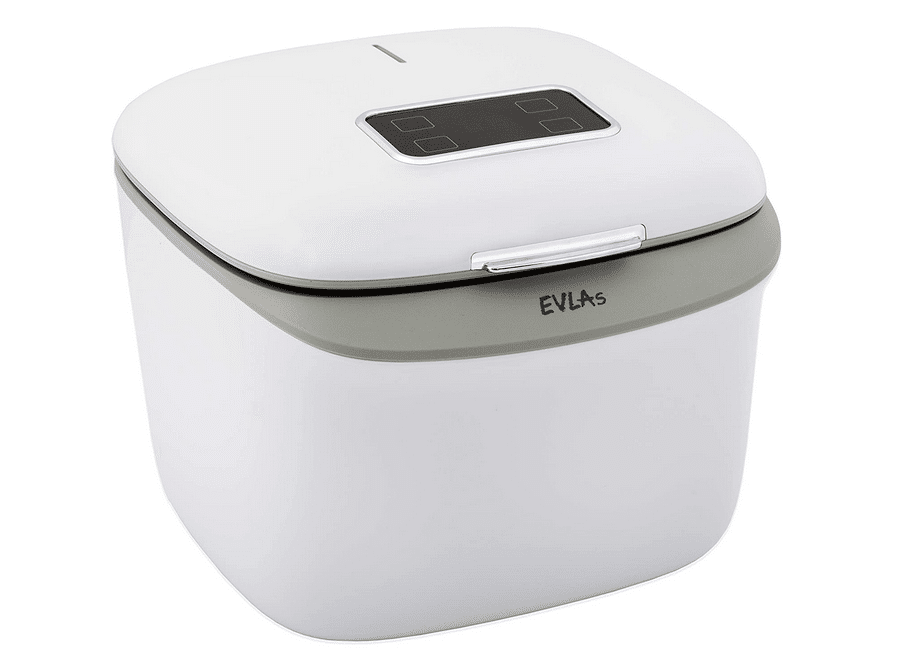
Runner Up
EVLA’s UV Hospital Strength Sterilizer
Editors note, 03/2021: This product is out of stock on Amazon. We will update this review when it comes back in stock.
This is an award-winning product, and similar to the Wabi, need not just be for baby products. While EVLA’S does not disclose lamp strength, their representatives dislcosed to The Unwinder that they use a Philips TUV 4W bulb. EVLA cites a quite-reasonable time-to-99%-disinfection of 11 minutes. The product is large enough to fit baby bottles, and so can easily accommodate multiple phones, TV remotes, keys, jewelry, or toothbrushes. Similar to the Wabi, the EVLA’S has a “sterilize only” mode that disables the drying cycle used for baby bottles, making it a safe choice for any of your electronics or other every-day-carry sundries.
The Details
- AWARD WINNING: National Parenting Product Award and Baby Maternity Magazine Top Choice Award
- Realistic disinfection time of 11 minutes.
- ETL and FCC approved
- BPA, Phthalate and lead-free
- UV-only setting for electronics
As we’ve said, for those who are serious about investing in UV disinfection, baby-focused products are the way to go. While this is a top-loader, and lacks the name-brand lamps of the Wabi, it is a regulatory-compliant, award-winning product that will last.
Another Good Option: Best UV Sterilizer
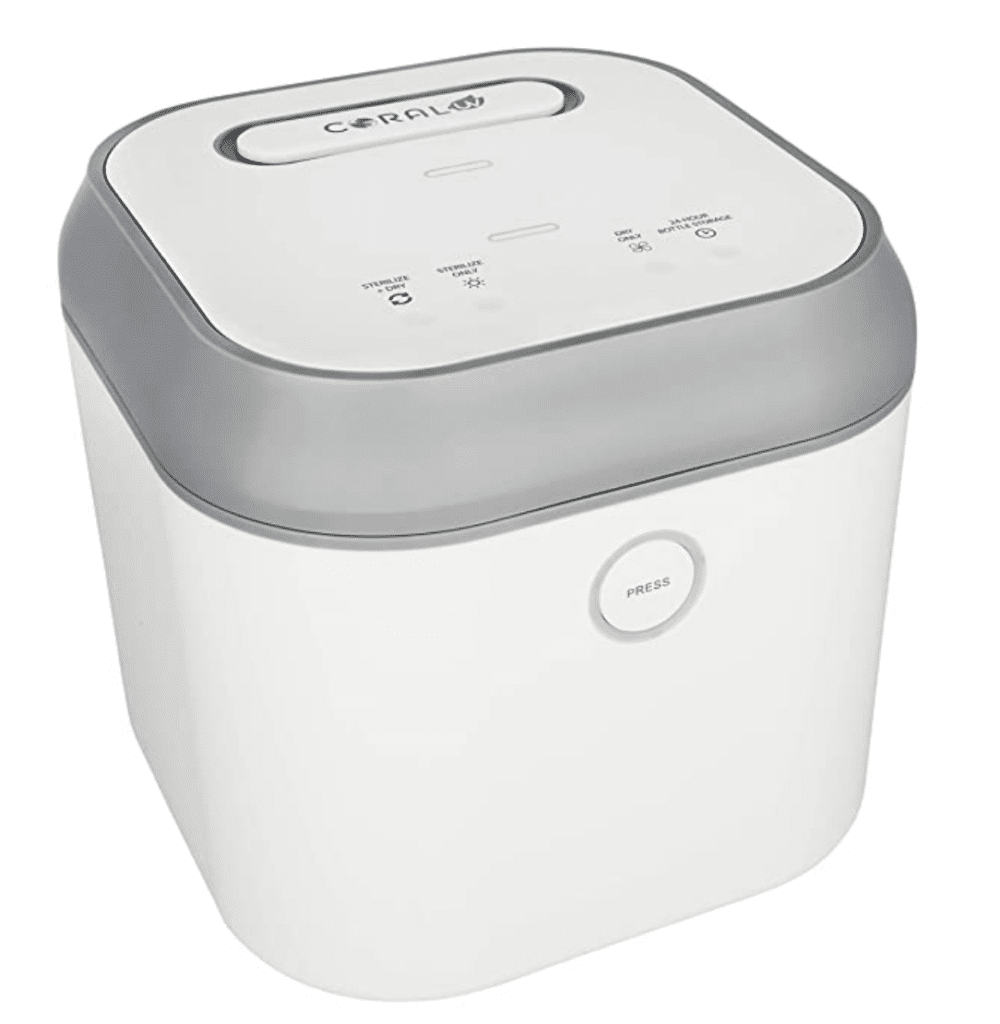
Another great UV light box option—if it’s in stock
Coral 3-in-1 UV Sanitizer and Dryer
High quality UV lamps ensure peace-of-mind sanitization
While it is made for baby, nothing’s stopping you from putting basically anything you want sanitized in this device. If you want total peace of mind from your sanitizer, this Coral device is the best choice. Coral advertises that its bulbs are 55W, which at minimum will get your stuff disinfected in about 90 seconds (though its quickest setting is 10 minutes). It’s tested by an independent lab. The “UV Only” setting lets you sanitize your electronic devices without worrying about overheating the batteries. This sanitizer is an investment for everyone in your home.
One More Recommendation For Best UV Sterilizer
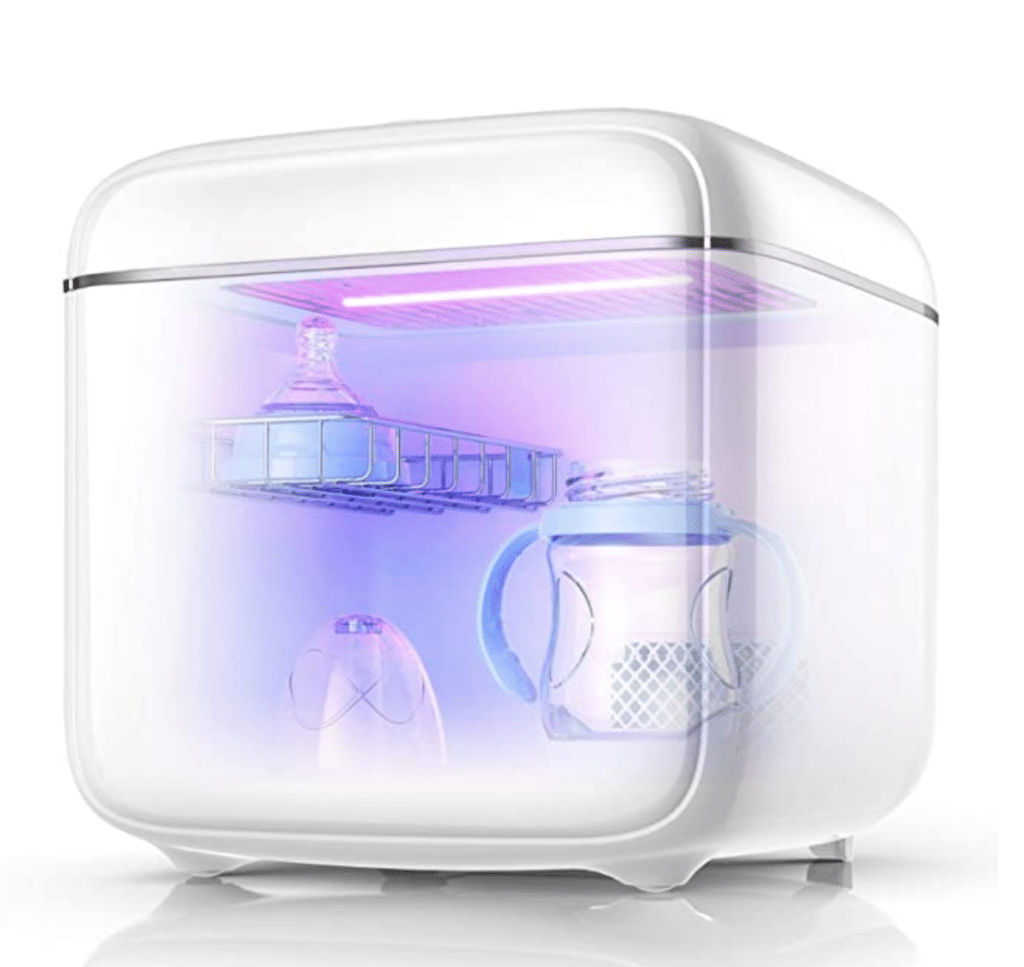
Another UV sterilizer runner up recommendation
Grownsy UV-Clean Sterilizer and Dryer
Uses Philips G5 8W UV bulbs
Yes, another baby product at the top of this review. Truth be told, as the pandemic has progressed, UV light sanitizers on Amazon seem to be perpetually out of stock, not powerful enough to disinfect anything, or fail to list their wattage or lumen output. Point being, if you want to buy something that actually works, you’re mostly stuck with baby products. Luckily, Grownsy’s UV sanitizing box uses Philips G5 germicidal UV bulbs; read the technical specs here. This bulb, while 8W, puts out 2.4W of UV-C light, which is sufficient radiation output to disinfect your devices.
Best Portable UV Light Sanitizers: Our Recommendations For The Best UV Sanitizing Wand
A UV light sanitizing wand is potentially the least ‘airtight’ version of an ultraviolet light sanitizer you can buy, simply because the amount of time and distance you spend hovering the wand over any part of a given surface is going to be variable. For example, if a portable light sanitizer advertises that it kills 99% of germs in 10 seconds if you hold it within 6 inches of the surface—let’s say it’s an airplane seat back tray table—surely they’re only referring to the part of the surface that the wand is shining on.
So to cover an entire airplane seat back tray table, you would have to incrementally move it along the surface staying within the recommended distance, covering each portion of the tray table for the recommended amount of time. And you have to keep track of how much time you’re spending on each portion of the tray table. Ultimately, you may spend 2 to 3 minutes disinfecting the tray table, as well as compromising your dignity in front of your fellow airplane passengers.
And then you have the other side of the tray table to think about. So maybe just use a Purell wipe for the airplane stuff.
That said, handheld UV light sanitizers do work if used appropriately. And they are useful in certain circumstances—for example, disinfecting silverware at a restaurant, disinfecting your phone in a pinch, or otherwise disinfecting small objects that can be illuminated all at once by the device.

Portable UV sanitizer
UVLIZER Extra Powerful UV Light Sanitizer
Time for 99% disinfection: 14 seconds
UVLIZER’s UV light sanitizer uses 2 watts to disinfect surfaces, meaning that you should be able to disinfect surfaces with the UVLIZER at a distance of an inch for just under 30 seconds. It’s LED powered.
Buying direct helps small business, but if you prefer buying from Amazon, we totally get it. That’s why we included two buy buttons for you to shop from.
The Details
- 2 watts
- Will disinfect surfaces at a distance of 1 inch in just under 30 seconds
- You can buy a warranty for this product
- Money-back guarantee
- Customer support
- Child lock—important because if used incorrectly, can cause material damage to the skin and eyes
- Convenient—it’s USB rechargeable

3.4 W ‘Mini roomba’
UVLizer UV Sanitizing Bot
Great for travel and at home
This portable Roomba-like device uses 3.4 W—which you can assume emits around a watt of UV-C light—to automatically sanitize surfaces when you’re on the go. The brand advertises between 30 and 60 minutes for the device to disinfect the surface of a hotel bed, which is roughly in-line with what our table above would predict out of a 1-watt device. Those important considerations aside, this device is pretty cool—just like a Roomba, this device automatically travels surfaces you put it on, disinfecting them as it rolls along.
Best UV Phone Sanitizer
Phones get gross. We carry them everywhere, put them down everywhere, and touch them to our face. Disinfecting your phone is a highly recommended practice. Apple came out in March, 2020, recommending users take cleanliness practices with their phones, but they did warn that alcohol-based wipes will eventually damage the oil- and smudge-resistant coatings of the phones.
A UV-C-based phone cleaning case can be a great option. Most of the devices in this category are LED-based, a good thing because LEDs emit a lot less heat than mercury-vapor lamps. However, in this category in particular, many manufacturers do not disclose the power rating of their LEDs. While a device that discloses wattage or lumens is preferred, for phone cases this nondisclosure is somewhat more palatable due to the closeness at which the LEDs sit to the phone while in the advice.
That said, we have three recommendations when choosing and using a UV light sanitizer for your phone. First, turn off your phone before disinfecting. Second, if LED power is not disclosed, follow the “Generic LED” time in the chart above. If the LED sits closer than 1″ to the phone, you can safely cut down that number a bit.

Our recommendation for best UV phone sanitizer
PhoneSoap 3 UV Phone Sanitizer
PhoneSoap and HomeSoap are made by the same company, and as we said above, they don’t seem to disclose lumens or watts. But we have good reason to believe the product is trustworthy and effective—several people have used laboratories to test their devices after use and found them germ-free.
PhoneSoap is built for all smartphones, and charge your device while it’s sanitized. It takes 10 minutes to sanitize. It’s one of the nicer-looking UV sterilizers for phone on the market, and available in a variety of colors.
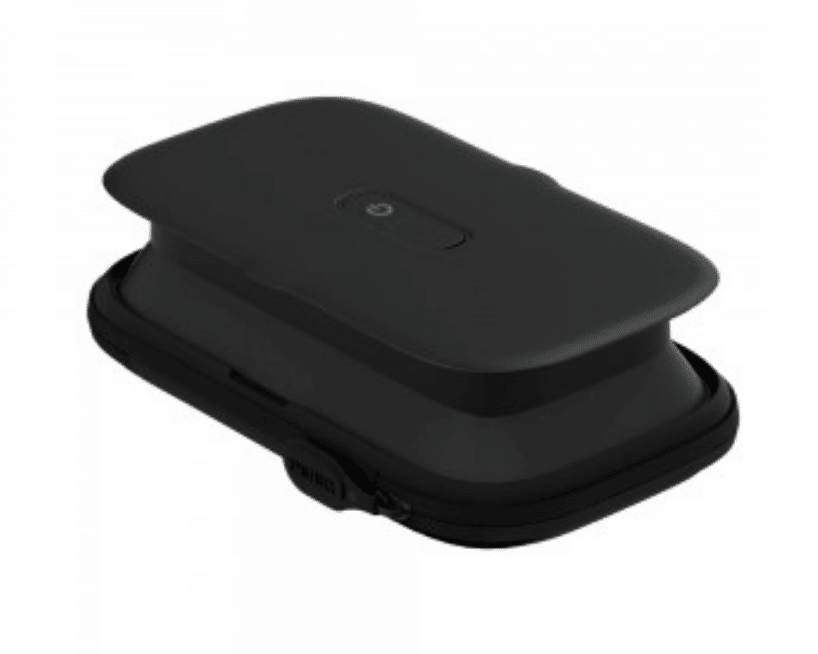
Our runner up recommendation
HoMedics UV Phone Sanitizer
Rechargeable and from an established brand
HoMedics is a company based out of Michigan that’s been in the healthy light space for over 30 years. Their UV light sanitizer for phones is discreet, sleek, and small enough that it can fit in your purse or other small carry-on. 2 LED UV lights run the device and disinfect both sides of your phone in one minute.
Based out of Michigan, HoMedics has been in the healthy light and wellness space for over 30 years. Their UV-Clean phone sanitizer will fit in your backpack, gym bag, or suitcase—it’s compact and discreet. Advertised as killing up to 99.9% of bacteria and viruses, the device’s two germicidal LEDs are positioned to kill the maximum amount of germs possible.
The Details
- Fits most phone sizes, including larger sizes like the Google Pixel 3
- 2 UV-C Germicidal LEDs at 70 cycles per charge
- Powered by one lithoum ion battery (included)
- Comes in black, red, and purple
The HoMedics would be our top choice in the phone category if they disclosed the irradiance of their UV LEDs (watts or lumens). The Unwinder has requested this information and will update if and when HoMedics responds.
Editors note: we are regularly updating this review. If you have your own experience with any of these products, issues with the review, or just want to say hi, please email us at hello@the-unwinder.com.
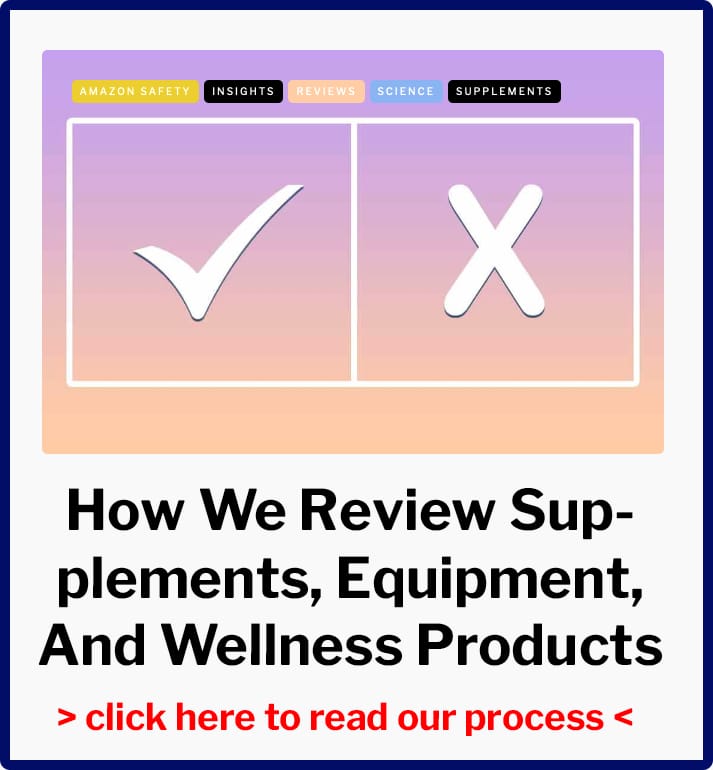
Testing a Verilux CleanWave Portable Sanitizing Travel Wand at 1cm over an American Ultraviolet UVC dosimeter, I get approximately 50 mJ/cm2 after 30 seconds. So over the length of the 10cm bulb, which seems to illuminate about 2cm width at 1cm height, I’d calculate 50/30*10*2=33mW output, normalized to 260nm.
The Casetify looks promising. https://www.casetify.com/protects/uv-sanitizer#16001088
What are your opinions of this UV Case Box? Some specs they publish are below.
Power input = 5V/2A
Size = 245 x134 x60mm
Interior Size = 220 x 115 x 35mm
No. of bulbs = 6 x 2mw
UV wavelength = 260-280nm
UV life = 10000 hours
Sanitizing time = 3 mins
Hi Steve, this one looks OK to me, though I think they are being a bit aggressive in saying 3 minutes is the 99.99% disinfection time.
If we assume that those 6 LEDs output 100% of their power onto the object, and assume a distance of 1cm, I still get a disinfecting time of 5.6 minutes.
So, if you get this one, I’d round up to 6 minutes. It looks like it has a 15 minute cycle option, so I’d even just go with that. Thanks!
Hi there! Thanks for all this great info. I came across the Clean Tray from Key Smart. Specs below:
UV Wavelength 260-280nm
LED Qty 4 pcs
Input 5V 1000mA
Irradiance 2-4 mW/cm2
The wavelength seems in the correct range, but the irradiance seems low, what do you guys think?
https://www.getkeysmart.com/products/cleantray
I appreciate your help!
I have the same question as Maria on July 5, 2020. Your reply would be most appreciated.
Per your review I ordered the hand held uv sterilizer from uvlizer.com. I didn’t notice the day ordered that the website shows the wattage at 3W, and your review says it’s 7W. Also, the website doesn’t list seem to list lumens at all. The enclosed paperwork that came with the device shows the wattage at 2W. So I wonder if it’s 2 or 3? What happened to the 7W option that you reviewed? What are your thoughts on this? I assume this means to get the same kill time that your review listed, I will have to use it for 21-49 seconds instead of 6-14 as you stated? What are your thoughts on this? I’m wondering if I should return it and get one of the others you reviewed. The biggest concern is she website listing it as 3W and the paperwork listing it as 2W. I appreciate your thoughts on this guys!